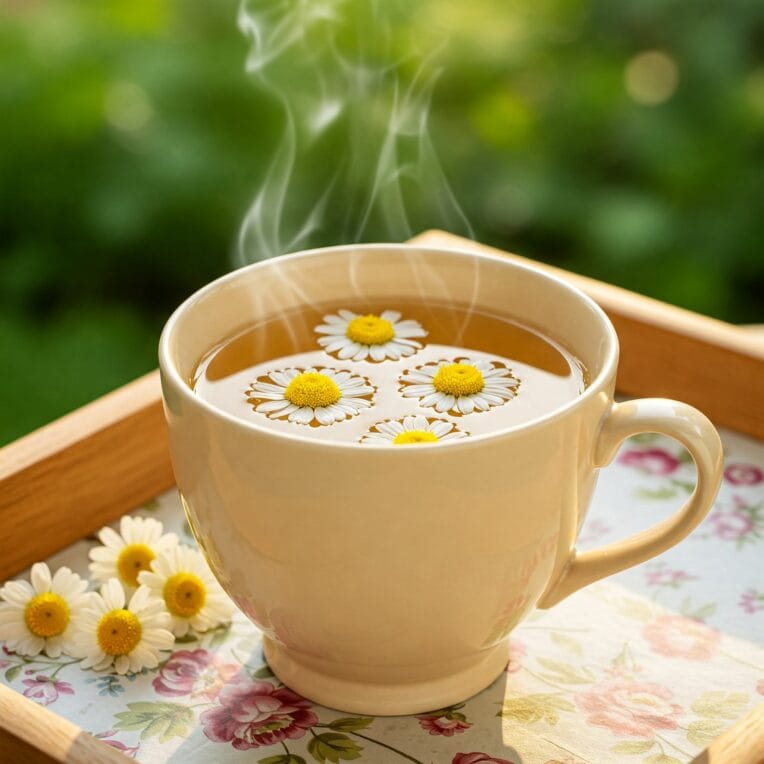Chamomile tea, derived from the dried flowers of the chamomile plant, has been revered for centuries as a natural remedy for a myriad of ailments. Its gentle floral aroma and soothing properties have made it a beloved beverage across cultures. This article delves into the world of chamomile tea, exploring its origins, preparation, health benefits, and offering tips for maximizing its therapeutic potential.
A Brief Introduction to Chamomile
Chamomile, belonging to the Asteraceae family, encompasses two primary species utilized for tea: German chamomile (Matricaria chamomilla) and Roman chamomile (Chamaemelum nobile). While both offer similar benefits, German chamomile is more commonly used due to its higher concentration of active compounds. Originating in Europe, chamomile has now spread globally, thriving in temperate climates. Its daisy-like flowers, with white petals and a yellow center, are harvested and dried to create the fragrant infusion we know as chamomile tea.
Brewing the Perfect Cup: A Simple Ritual
Preparing chamomile tea is a simple yet mindful process that allows you to fully appreciate its calming essence. Here’s a step-by-step guide:
Ingredients:
- 1-2 teaspoons of dried chamomile flowers (or one tea bag)
- 1 cup of water
What utensils we need to make the tea ?
- Kettle or pot for heating water
- Mug or teacup
- Tea infuser or strainer (if using loose flowers)
- Spoon
Instructions:
- Heat the water: Bring the water to a boil, then remove from heat and let it sit for a minute to cool slightly. Ideally, the water temperature should be around 200-212°F (93-100°C). Avoid using boiling water as it can make the tea taste bitter.
- Prepare the tea: Place the chamomile flowers or tea bag in your mug or teacup. If using loose flowers, utilize a tea infuser or strainer for easy removal.
- Steep: Pour the hot water over the flowers or tea bag. Cover the mug with a lid or saucer to retain the heat and volatile oils. Allow the tea to steep for 5-10 minutes, depending on your desired strength. Longer steeping times result in a more potent brew.
- Strain and Enjoy: Remove the tea infuser or tea bag. If using loose flowers without an infuser, strain the tea through a fine-mesh sieve. Your chamomile tea is now ready to be savored. You can add a touch of honey or lemon to enhance the flavor, if desired.
Unveiling the Health Benefits: Nature’s Gentle Healer
Chamomile tea has been traditionally used for its diverse therapeutic properties, supported by modern scientific research:
- Promotes Relaxation and Sleep: Chamomile’s calming effects are primarily attributed to its apigenin content, a flavonoid that binds to certain receptors in the brain, reducing anxiety and promoting relaxation. Studies have shown that chamomile tea can improve sleep quality and reduce insomnia.
- Aids Digestion: Chamomile possesses anti-inflammatory and antispasmodic properties that can soothe digestive issues such as bloating, gas, and irritable bowel syndrome. It can also help relieve stomach cramps and promote healthy digestion.
- Boosts Immunity: Chamomile contains antioxidants that strengthen the immune system and protect against infections. Its anti-inflammatory properties can also help reduce inflammation throughout the body.
- Relieves Cold Symptoms: Chamomile tea can provide relief from common cold symptoms such as a sore throat, runny nose, and cough. Its warm vapors can also help soothe a stuffy nose.
- Skin Health: Chamomile’s anti-inflammatory and antiseptic properties make it beneficial for skin health. It can be used topically to treat minor skin irritations, wounds, and even eczema. Its ability to lighten skin and reduce acne is also recognized.
- Menstrual Cramp Relief: Chamomile’s antispasmodic properties can help relax the uterine muscles, reducing the severity of menstrual cramps.
Tips for Maximizing Chamomile’s Benefits
- Choose High-Quality Chamomile: Opt for organic chamomile flowers or tea bags from reputable sources to ensure purity and potency.
- Steep Time Matters: Adjust the steeping time based on your preference. For a milder flavor, steep for 5 minutes, and for a stronger brew, steep for up to 10 minutes.
- Enjoy Before Bedtime: To promote relaxation and sleep, drink chamomile tea 30 minutes to an hour before going to bed.
- Combine with Other Herbs: Chamomile can be combined with other calming herbs such as lavender or lemon balm for enhanced relaxation.
- Consult a Healthcare Professional: While chamomile tea is generally safe for consumption, it’s always advisable to consult a healthcare professional, especially if you are pregnant, breastfeeding, or taking medications.
Chamomile tea, with its delicate flavor and impressive array of health benefits, offers a natural pathway to tranquility and well-being. Incorporating this soothing beverage into your daily routine can help you unwind, improve sleep quality, and promote overall health. Embrace the ritual of brewing and savoring a cup of chamomile tea, and experience the gentle embrace of nature’s calming elixir.







